Football Madness in the Piedmont, Part 1
November 22nd, 2004
By Keith Neal
kneal at asist dot net
Gentlemen, if you ever get much of a chance to go dig around in your local library or high school, you can strike gold. Gold nuggets of information can be found about football from an era long gone but still relevant to today. I have been doing some digging and I find that the more I dig, the better the stories become and the clearer the pictures gets. Now keep in mind that I am a relative newcomer to this whole world of direct snap football and I learn a lot every day just from being on the Delphi board. I claim no expertise here. But I have to admit that I am hooked. There is something intoxicating about the whole idea of putting ideas into practice that have been around for three or more generations. The utter simplicity and beauty of single wing football just grabs you if you are even half a fan.
I have, for a week or so now, been looking for any sources about football as played around my home (western NC) in the 1920s and 1930s. In the course of the beginning of this journey, I have discovered some delightful stories and vignettes that I would like to pass along here. It is evident to me that the school boy game (which was by the time period in question well established in other parts of the country and some parts of the state) was just beginning to take off in this part of the state. In the middle and late twenties, it would appear that football madness had taken hold of the North Carolina back country. Towns like Shelby and Hickory and Lincolnton were getting their elevens together to do battle with each other and with the more established teams of the eastern Piedmont. The early ad hoc efforts must have resembled earlier efforts in towns and colleges all across the country as the game took hold. If you look at scores from the early days, it is not a pretty sight. For example, Shelby, which had played football as early as 1911 but did not do so regularly until 1920, lost a 1920 game to a school called Baird Prep by a score of 100-0. But apparently they thought this was just an aberration, so they pressed on and by 1922, under Coach R.N. “Dick” Gurley, they were able to advance to play Monroe in the state championship game. This was a game that was suspended at dark and at the end of a fifth quarter with the score tied 6-6. When play was resumed the next day, Monroe was able to pull out a 14-6 victory.
Dick Gurley was not done though. He would go on to coach other teams, notably the Newton High School team. The reason I mention him again is that there is a funny coincidence here. The sports writer for the Lincoln County News, one Jake Rudisill, had the quaint habit of referring to teams by the name of their coach. I suppose it was a touch of rhetorical opulence but it did lead to the following situation. The coach of the Lincolnton team was “Block” Smith and Rudisill, at times, referred to them as the “Smithmen”. Hence, the Newton team is referred to as the “Gurleymen” on a number of occasions in newspaper accounts of the game. I don’t suppose that he saw the humor in it any more than California Democrats.
Now, I said earlier that a kind of football madness had settled over this part of North Carolina in the twenties and thirties. Here is why I make that assertion. The papers in the early thirties are full of stories of great weight and gravity. In the midst of the Great Depression one would expect exactly the kinds of things that do indeed appear in the paper. In some issues there are a couple of pages dense with listings of properties due to be auctioned off for taxes “at the courthouse door”. Stories about people being hopeful that banks would be able to reopen after Federal intervention to save them are not in short supply. Advertisements for the National Recovery Act Trade Days are everywhere. Hot debates over the issue of Prohibition are prominent in almost every issue too. There are also stories of labor unrest in Charlotte and associated violence. But lo and behold, as you continue to dig through the papers, it hits you right in the face. There it is, right on the front page of an early September issue of the Lincoln County News: Block Smith Gloomy As High Gridders Begin Drills. The story details how Lincolnton coach C.D. “Block” Smith has his boys out drilling for the upcoming season. The story describes the pessimism of the coach for the upcoming season as he has lost all but 5 lettermen and has the “lightest group of ball toters in years.” In fact the guy who ended up being the star halfback for LHS that season weighed in at 135 pounds. The point is, however, that this was front page news material in a time when there was much news in other areas that might well have deserved the two column front page space taken up by the Lincolnton football team.
In fact, for a couple of weeks after the season started, the scores and game accounts were on the front page of the paper. It is also worth noting that as the team’s fortunes waned they were relegated to a place further back, in the schools or social section. Lincolnton won only 3 games that year and a 7-6 loss to powerhouse Hickory was written up as if it were the modern equivalent of the last stand of the 300 Spartans. But by the end of the season, schoolboy football was sent to the back pages of the paper. I guess the bandwagon effect is nothing new.
It is also worth noting that the practice of high school teams playing junior college teams or B teams from local four year colleges was still fairly common. The Lincolnton “second eleven” had a game with the B team of Belmont Abbey College. During this same period, Hickory High was recorded as playing Belmont Abbey and Rutherford College. That is an area that bears further exploration but as yet, I have only cracked the surface here.
If one requires further evidence, there is plenty of it. Lincolnton was scheduled to play Concord the last game of the 1933 season and the Lincoln County News printed a story (a plea almost) on the front page urging the town to turn out at the ball field in big numbers. This was to counter the flood of invaders in the form of the entire student body of Concord High School, that was rumored to be coming to Lincolnton with their team. The story goes on to say that that Concord school authorities granted the student body a half day holiday each year to follow the team to an away game!!!!
Now if that does not cinch it for you, consider the following: There was a story after the end of the 1933 season that was publicizing the upcoming game between the Lincolnton All-Stars and the Charlotte Bulldogs, a professional traveling team. The Lincoln County News made the game out to be a big deal and the ghosts of old Lincolnton teams were invoked. (This was the case, although football as a regularly occurring interscholastic game was only played there a little more than a decade or so previously.) The paper reminded readers of the past great exploits of the members of the Lincolnton All-Star team. The Lincolnton team won 12-0 and this too was a big deal. (One wonders if the Bulldogs gave it their all seeing as they might want to be invited back next year for a split of the gate.)
At any rate, this all feels like a great adventure in the making. I will, if you don’t throw too many tomatoes my way, occasionally keep you up on the world of football in western North Carolina in the twenties and thirties. In the meantime, you really owe it to yourself to go to a place that has old papers or yearbooks or any kind of records and spend the afternoon digging and looking. It is an amazing world.
It’s the Kids’ Game
November 15th, 2004
By Richard Bridgeo
rwbridgeo at comcast dot net
I think my approach to youth football is a little different from other guys. I believe the key to success in youth sports comes through having your players concentrating on the game and taking their own responsibility for success. How many times in games have you seen kids just standing there taking a play off or half-heartedly going through the motions? They do this because there is no responsibility placed directly on them for their actions. Kids are so used to having adults tell them what to do, that it permeates into their games too. I know my kids don’t always do things the first time I tell them to, but if I hold it over their heads and tell them something like, “We’re not going to the mall until you finish vacuuming.” You bet they’ll vacuum!
I use a similar approach to football. Why send a play into the huddle where the only ones who hear it are the quarterback and the kid who is going to get the ball? It is their game so let them make the decisions and determine their own success. The way we do things, when the tailback comes to the line of scrimmage, everyone listens intently for the play. Then they run it. The tailback knows he is responsible for his decision and will make the maximum effort to insure its success. Everybody else hears the play call seconds before its start and has to quickly recall their assignment. If someone screws up, they get an earful from their teammates. With that kind of minutiae going on, everyone is going to focus into the game. On the other hand maybe it will be the defense who is spacing out. The bottom line is we only have 4 or 5 plays, how can we really screw it up? If the tailback was not making the call I would be making a call by chance, or by what I think I see.
Plays not included on our play sheet are pass plays. We have several but passes are off-limits for the tailback to call, otherwise they would just pass on every down! If the team gets into a jam, down and distance-wise, then I’ll send in something off the bench via either signal or messenger.
We do not punt. We play four downs all over the field. If we get stopped inside our own 10-yard line, we will take an intentional safety and free kick from our own 20.
I once read that in football 70% of all long gainers (gains over 20 yards long) occur from plays run to the wide side of the field as opposed to the “boundary”. Hence, we always line up with our strong side and run our base play to the “field”. One season our base play was “7 Sweep”. We’ve read about the success of the sweep in youth football. This was a no-brainer: run sweep to the wide side of the field as your base play. On another occasion we lacked speed and used the “6 Tailback Power” as our base play that season.
The No-Huddle Offense
When most people think of football they think of the offensive team going into a huddle where the quarterback calls a play. Once the play is called, the team breaks out of the huddle into a formation, the quarterback calls the signals, and the play is run.
In the no-huddle offense the huddle is merely replaced by a base formation from which the quarterback, or in our case, the tailback reads the defensive alignment and calls the play at the line of scrimmage. In essence, the base formation is the huddle and the play is called in coded speech, or what is known as an “audible”. To some people it may sound risky and radical, but it is not. Actually, it is very easy and straight forward.
This is how it is done. The tailback stands in shotgun position, a position five yards behind the football and signals to the team the formation to line up in. Since we only have two formations — wide left and wide right, this is not difficult. The tailback looks to see where the wider side of the field is and then signals the formation to the team by pointing with his arm to line up to the wide side, either wide left if the wider side of the field is to the left, or wide right if the wider side is to the right. Once the team is set, under normal conditions, they play is always “6 Tailback Power”. The tailback yells any two numbers except “13″ and then the cadence, “Ready-Set-Go!”. The snap is always on “Set-Go!”.
However, there are times when we want to charge the play. Later we will discuss this issue in further detail. However, it is very simple. After the team lines up and before the tailback begins the cadence, he looks at the defense and counts the defensive players to the short side of the snapper. If he sees four or more defenders, then it is safe to run the play, “6 Tailback Power”. If he sees less than four, he yells “99″. “99″ is the signal, or audible, for the backfield to shift. The tailback waits for all the backs to shift to the other side then on “Set-Go!” the tailback takes the snap and runs “6 Tailback Power” in the other direction.
After a while, even the dumbest team will realize that when we shift the plays goes in the other direction, so it is likely that they will shift over when they see us shift. When that happens, instead of of call “99″, the tailback yells, “13-4″. “13″ is the hot number or signal that we are changing the play and “4″ indicates that the play is changed to “4 Reverse”. Then on “Set-Go!” the team runs “4 Reverse” instead.
Some teams might not take such a radical approach in adjusting to our unbalanced line. Some teams might just position one or more players to stop “6 Tailback Power” at the point of attack. In that case, most of the time it will either be the defensive tackle or linebacker. Whenever a tackle lines up on our outside tackle or a linebacker lines up on our tight end, the play should be changed to “2 Blast”.
We can also audible to change the snap count. Since the snap count is always on “Set-Go!” to change it to “2″ (”Set-Go-Go!”) the tailback yells out any day of the week (Monday, Tuesday, etc.). That is the signal that the snap count has been changed to “Set-Go-Go!”.
How to Read the Defense
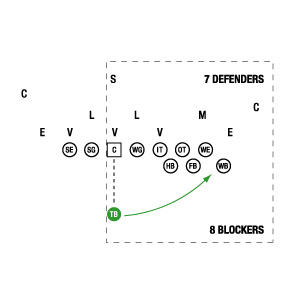
The defense lines up wrong when they line up on the snapper. They only have seven defenders to the right of the snapper and we have eight blockers. Count them.
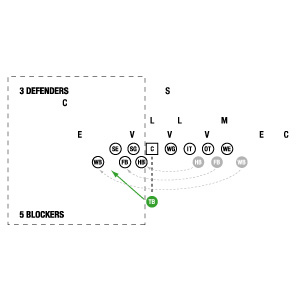
When the defense lines up correctly they have only three defenders to the left of the snapper. When this happens we should call “99″ (shift). Now we have five blockers to only 3 defenders.
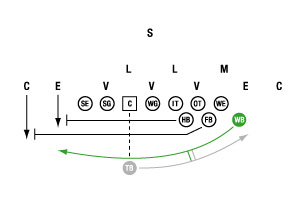
If the defense shifts when we shift, then “4 Reverse” should be called.
The Running Plays
Here are the plays we run. They are shown from wide right formation, but we also will use wide left formation as well.
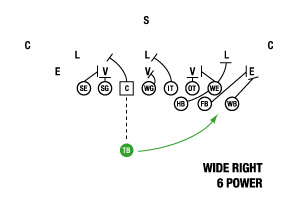
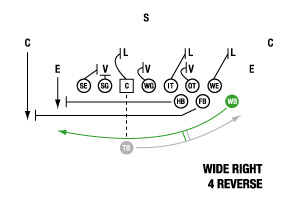
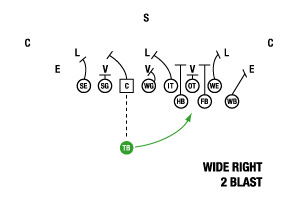
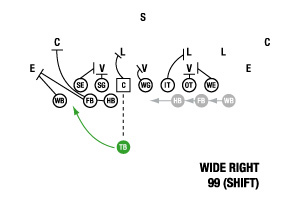
Historical Perspective: Pop Warner
November 8th, 2004
“The greatest game that a coach can win is the one that develops a boy into a man.”
- Pop Warner
Many have asked, “Who has had the greatest influence on the game of football and the NFL?”. Almost all would respond, “Glenn S. (Pop) Warner”.
“Pop Warner” was born April 5, 1871 in Springville, New York, where he was an outstanding baseball player at Springville’s Grifith Institute, which he graduated from in 1889. He attended Cornell University, where he graduated in 1894 with a law degree. His first encounter with football came here, where he also particitapted in baseball, track and boxing. As captain of the football team, he got the nickname “Pop” because he was older than most of his teammates. Pop had originally intended to become a lawyer (he did practice for a short time), but he soon established himself as one of the greatest architects in the game of football.
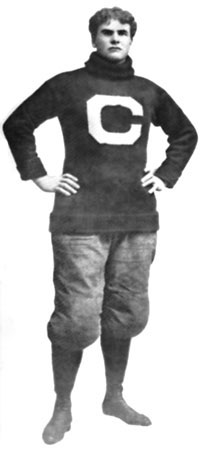
In 1895, the University of Georgia hired Warner as its new football coach at a salary of $340 for ten weeks. He arrived in Athens on September 15, 1895, homesick and discouraged after seeing the sports facilities and staff at his disposal. At the time, the University of Georgia had no athletic facilities, playing field, or stands. In fact, the only place for playing football or any other sport was a bare field behind New College where rocks stuck out of the red clay. In 1895, the University of Georgia’s entire student body consisted of just 248 students, and only 13 of those showed up to play football. As a result, Warner’s first team, the 1895 squad, had 3 wins against 4 loses. Warner was rehired for the 1896 season at a salary of $40 per week. The Warner’s last Georgia team went 4-0, giving the University of Georgia its first undefeated season.
After Georgia, Warner returned to Cornell to coach football for two seasons. He then coached at the Carlisle Indian School in Pennsylvania for five years, returned to Cornell for three seasons, and returned again to Carlisle in 1907-the same year as Jim Thorpe arrived. Warner went to the University of Pittsburgh in 1914, coaching his teams to 33 straight victories and two national championships. Next, Warner coached at Stanford, where his teams won three Rose Bowl championships. In 1933, he took his final coaching job at Temple University with only one losing season before retiring in 1938.
Warner fielded teams at Iowa State, University of Georgia, Cornell University, Carlisle Indian Industrial School, University of Pittsburgh, Stanford University, and Temple University. On two occasions he coached two schools simultaneously; Iowa State and University of Georgia during the 1895-1896 season as well as at Stanford University and University of Pittsburgh during the 1922-1923 season.
During his four decades as a coach, Warner brought many innovations to college football, including the spiral punt, the screen play, single- and double-wing formations, the naked reverse, the three-point stance, numbering players’ jerseys, and the use of shoulder and thigh pads. But to many Americans, Warner is best remembered for starting the Pop Warner Youth Football League in 1929. On September 7, 1954, Pop Warner died in Palo Alto, California.
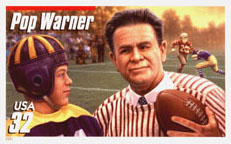
In 1997, the U.S. Postal Service honored Warner by placing him on the 32 cent postage stamp shown above. This honor may have been helped by author Michael J. Bynum, who in 1993 authored the book “Pop Warner: Football’s Greatest Teacher” and uncovered a long overlooked fact about the famous coach; Warner was the coach of Iowa State during a period in which his team compiled a record of 28 wins, 12 losses and 1 tie. This oversight can be attributed to the fact that Warner had also been coaching at the University of Georgia during this time period. With these numbers, Pop Warner surpasses Bear Bryant’s career coaching record to become College Football’s all-time “winningest” coach.
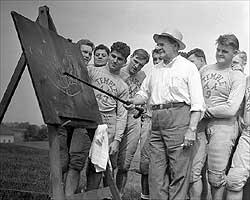
Glenn Scobey Warner Statistics
Born: April 5, 1871
Died: September 7, 1954
* Coached 7 colleges, over 49 years
* 341 victories; 118 defeats; 33 ties
* Outscored opponents 8,795 to 2,810
* Produced 47 All-Americas, including Jim Thorpe and Ernie Nevers
* Became known as “The Great Originator” as coach of Jim Thorpe and the Carlisle Indians, Pittsburgh, and Stanford
* College Hall of Fame Name: Glenn Scobey Warner
* Schools Coached: Carlisle, Cornell, University of Georgia, University of Pittsburgh (1895 - 1938)
* Coach Hall of Fame Induction Year: 1951
Innovations
* Three point stance
* Wingback formation
* Bootleg
* Screen pass
* Spiral punt
* Shifting Defenses
* Rolling body blocks
* Hidden ball
* Unbalanced line
* Huddle
* Perfected the spiral pass
* Fought tooth and nail AGAINST the forward pass in 1905, against (among others) John Heisman. Warner wanted a rule that would allow offensive players to field punts like forward passes, much the same way rugby players do.
Equipment Innovations
* Numbers on player’s jerseys
* Perfected the use of fiber padding
* The use of thigh and shoulder pads
* Knee guards
* Shin guards
* Tackling dummy teams
Content provided by University of Georgia and PopWarner.com
Snap & Go!
Adam
adam_wesoloski at yahoo.com
Dummies Guide To Solid Blocking
November 1st, 2004
Todd Bross Head Coach, Keystone Catholic Firebirds Youth (4th-6th grade) Football Team Sharon, Pennsylvania
At the 2002 National Single Wing Symposium Coach John Ward, now at Union High School in North Carolina, explained, defended and demonstrated the solid (or wedge) blocking scheme during a 15-minute break between presentations. It’s easy, effective, requires little memorization, and is very easy to install. It has very few standardized rules, and an entire offense can be run from this one scheme. He has used it at the high school level with good success running power, off-tackle and a lot of full spin. Youth coaches use it as well with great results. He convinced me, and we use this scheme for our entire offense. We were able to install the blocking for our entire offense in one practice — the 3rd practice of the year! Whether you choose to use this exclusively or as a feature in a series, I think it is truly offensive line play at its purest…”We are going to kick your butt, and there is nothing you can do about it”.
There is no pulling, no fancy footwork, no “me-you” calls, no 1, 2, 3, 4 whatever techniques, no trapping, no nothing except kicking your opponent’s butt downfield play after play. By sealing all the inside gaps you disallow any backfield penetration, which gives backs the time to carry out misdirection plays. It also allows smaller teams to play hardnosed against bigger opponents through the use of down/angle blocking and the double teams they create. With no rules to learn, any player can play any line position from any formation on any play. The linemen are freed from thinking and encouraged to hit.
The Idea: Create a “pile of bodies” 2 levels deep at the center of the line. By down blocking on both sides of the ball, a team gets on every play:
1) 3 down blocks at the point of attack (POA) which will often yield “accidental double and triple teams”
2) 3 inside gap blocks backside
3) 1 kickout block at the POA by the blocking back
4) We have also added one downfield trap/crackback block by our backside end at the POA called a “Pizza Block”
The Set: There are no “true” line splits. We coach the players to take “fist splits”, or a split the width of their closed fist from their teammate (approximately 3 inches). In an unbalanced 4-2 the 1st man to the long side of the center is the pivot, and the only lineman who may have a different first step on every play. In a balanced front the center is the pivot. Where having an inside hand down may help protect the inside gap, having the lineman comfortable is more important. Therefore not a lot of emphasis is given to which hand is down. Lineman are up on the line of scrimmage, not off it. Their stance can be either be the traditional down hand foot in a instep-toe relationship with their up hand foot, or even (toe-toe). Weight should be evenly distributed between the down hand and feet, to the point where if you were to knock the down hand out from under them the player would fall forward.
We have the center in a 3-point stance, free arm down just like all the other linemen, snapping with 1 arm, looking back. This will give him a more solid base to snap, step, and most importantly, receive a blow from the defense.
It is crucial to emphasize to the linemen that they are not blocking a specific player, but are rather “trains on tracks” and should block anything that crosses their tracks, but to not “jump the tracks” and chase a defender. This will create gaps.
Step Progression: 1st Step Rule: is every player step inside. The aiming/coaching point of this step is to “step just in front of the outside foot of the player inside you”. It is not a 90 degree lateral step or a 45 degree down step, but more a 60 degree angular step. With 3-inch splits, this is a short, quick step. Coach the players to just place their heel a few inches (approximately 3-4 inches) in front of the foot of the player they are stepping to. The position of this step is critical!
First Step Mistakes: Step at a less than 60 degree angle (the biggest, most common mistake) — gaps will appear behind and in front of them. Step at a greater than 60 degree angle — the player will have no drive plus create a gap behind them. Step too long (laterally) — they will create a gap behind them and their feet will be too wide and be easily pushed over.
The coaching point is a short, quick step that will, upon completion, have their heel about 3-4 inches directly in front of the toes of the player they are stepping to. Stay Low! Aiming point for contact is the thigh pads of a defensive lineman. Make sure they keep their eyes up. We coach the linemen to bring their “knees to numbers” and focus their “eyes on thighs”. This is not a hand blocking scheme. The idea is to deliver, along with the shoulder pads, a rising forearm blow while creating a wider blocking plane that further protects gaps. On the first step coach the players to load. Their elbows should draw back, but not too extreme — a short, quick pull back that, if the player is staying low, would have their hands level with the top of their thighs, like they are reaching for a holstered gun. Excessive backward movement defeats the purpose of this scheme.
Pivot First Step: Whichever player is the pivot is the only player with different first step footwork. Their rule is always step to the point of attack first! If the play is to the right, they step right; to the left, with their left. This ensures getting a helmet in the closest playside inside gap.
Note: You do not have to use a pivot position from an unbalanced set. Simply have the center always step to the longside every play for an even easier system. We did this with great success, especially running a direct snap offense.
All offensive linemen should move as one unit. Stragglers create gaps. United step progression is critical to solid blocking success. When practicing these steps, the linemen’s feet should sound like one giant foot landing — not a progression of steps.
Second Step: Everyone’s second step is with their other foot along the path they are on. Contact will definitely happen for some players now. Coaching point is to have them explode into the defender’s thighs with their forearm blow and shoulder pads.
The forearm blow is delivered by snapping both arms out and up with a rolling motion that ends with thumbs pointed down. The underside of the forearm is the contact area. This snap is crucial: 1) It provides a strong surface. Test it yourself. Raise your arms to simulate the snapping motion, but leave your arms unrotated with thumbs up. Now have someone push down on your arms. Repeat this but now rotate your thumbs down. You will find you have a lot more strength in this position than with your thumbs up due to your increased use of shoulder muscle. Youth coaches can demonstrate that their kids are stronger then they are with this demonstration very effectively. 2) The underside of your arm is a flatter, wider surface to strike and block with.
Note: Do not confuse this with the flipper/”icepick in the chest” technique.
With the first step the pivot and player to whom he is stepping towards will “bump” pads. Therefore their second step, although they should still step in the direction they were heading, will more likely be upfield as they press against each other. At the same time the players immediately to their outside will “bump” them on their second steps. This pattern of step, bump, and upfield will continue step-by-step.
Remainder of Steps: Continue Steps 1 & 2. Stay Low! The ideal block makes contact with the defender’s thighs and drives up no higher than their waist. Block too low or too high and a defender will be able to, primarily due to the fact his body doesn’t bend easily above or below the waist, bounce off. Get in his thighs to stop his motion, drive up to his waist where he bends pretty easily and bend in him in half by driving him backward.
Pizza Block: Whichever end is furthest from the point of attack steps just like anyone else and if someone crosses his face, he blocks him! If not, they continue their step progression until they are linebacker deep and head immediately to the point of attack. Find a defender (linebacker, safety, cornerback, trailing defender) and level him!
For off-tackle plays, coach a downfield trap. For outside (sweep) plays, have them go a little deeper and look for a downfield crack back on a defender, which could very easily be a highlight file decleater. To avoid clipping, have the end scream “Hey!” at the poor sucker he’s going to crush a few steps prior to impact so that the defender is facing him.
The pizza block is simple. The backside end’s block is best used downfield at the point of attack, not 5-10 yards behind the point of attack. If that block springs a touchdown, coach buys pizza for the entire team next practice.
Uncovered Linemen: If, after going through the step progression, a lineman does not have a defender anywhere along their path to block, do not release! Stay with the inside man always. Releasing creates gaps/holes, which could allow penetration. Coach the player to stay with their inside man, which will take some work. Since there are only two steps to learn, you should have lots of time for repetition and teaching how to be aggressive in a “controlled” manner. It’s discipline and they can learn it.
Simple Blocking Rules:
1) If a defender crosses your face, block him.
2) Do not block a specific player; block whoever gets in your way.
3) Collect “accidental double and triple teams” at all times
4) Stay low! Coach them to bring their “knees to numbers” and keep their “eyes on thighs” of the defense
5) Drive the defensive line into the linebackers, especially at the point of attack.
Blocking Back Progression: First Step: Always make a directional half step playside with the backside foot. This will allow the blocking back to get in position, get some momentum, and most importantly allow the line to make their first step. Stay low! Coach Ward calls this a “Sniper Block” in that the blocking back sneaks behind the wall of lineman and picks off “One man with one block”.
Second Step: A full step with the playside (other) foot, sneaking down the line of tailpads the line has created. Continue step progression to the target and make an outside shoulder block on the first defender to show at the outside of the point of attack.
Wedge: For plays at the pivot, wedge block. A wedge block is the same as a solid block, but no pizza block. Get up in the wedge and stay in there until if collapses, stalls or daylight shows. The pivot should always step to the center in a wedge block. If the center is the pivot, choose.
Installing Solid Blocking: This is one of the definite upsides to using this system. Since the entire scheme can be taught in one practice, this allows the linemen to get a significantly increased amount of reps in practicing the 2-step progression over the course of a season.
Have the players line up as a line, with correct splits. Use your snap cadence to set them in their 3-point stance, and then have them take their first step (all in the same direction) on “Load!”. Do not have them take both steps — have them freeze after taking their first step.
Check For:
1) Incorrect position of the step foot? (most important)
2) Are they too high?
3) Are their eyes up?
4) Are their backs level and shoulders square?
5) Are their feet under them?
6) Are their arms in the “load” position to deliver the “explode” forearm snap during the second step?
7) Did the line step as one, or did they step as individuals?
8) Did they move/step with their back foot?
Have them take first steps to both their left and right, everyone stepping the same direction.
Still freezing after their first step, next have them add the “explode” second step. Check for all the same things, especially staying low on the “explode” step.
After they have become good at the 2-step progression, gradually increase the speed. Go 50%, then 75%, then full speed. You will not be able to call “load” and “explode” now, use your offense’s cadence. They are still all stepping either right or left as a group.
Now, have the right half of the line step with their left foot first, the left half with their right foot. This is where it all comes together and the idea of no gaps will be come apparent. Return to freezing on the “load” step. The two players in the middle of the line will collide/bump. This is exactly what should happen since they both stepped with opposite feet. Check everyone for all the usual concerns. Now have them take the “explode” step. The two players who bumped will head up field, and the two players next to them will collide with them. What they should see and feel is all of them, pressed shoulder pad to shoulder pad, eyes up, staying low with arms extended, deliver a snapping, rising blow. No defender can come between them. They are now a solid wall.
Continue this progression, slowing increasing the speed until you are going full speed. It’s awesome to watch it come together.
Solid Blocking Drills: “Spider” We developed a drill to teach all the aspects of a successful solid block in a competitive way that maximizes time and repetitions. We call it “Spider!”, in that the first step of the block resembles someone stepping on the bug. Plus the kids like yelling it.
What You Will Need: An orange pylon (or something with a 12″ square base)
Set-Up and Drill: Have two players line up facing one another with the pylon between them. Have them place each of their right feet a few inches from the center of the pylon’s base, so that their feet are aligned opposite one another. They should be very close — only the width of the pylon apart at the helmet, ready to take a 3-point stance on the cadence.
On “Go!” (or whatever your cadence is) have each play take a “load” step, with the goal being to place the heel of their foot on their far corner of the pylon’s base before their teammate does. This is when the players yell (encourage it) “Spider!” and slam their foot down.
As in the actual game, the quicker player wins. However, you can now coach “style points”. Quickness means nothing if they are too tall and their opponent is under their pads, or in a better position to block. Have them freeze on the “Spider!” step and critique them, giving the player with the best form the “victory”.
What will happen, in a short period of time, is that each player tries to be the quickest, lowest, best prepared to “explode” — which is what you want. And they will start coaching themselves, noticing if they (or their teammate) are in better or worse position.
The more pylons you have, the more players can play. The entire line can face across from each other.
After a while, switch feet and step the other way.
Solid Blocking Drills “Shoe-eyy!” This is a great way to practice steps solo. It’s a spoof of the sound farmers make to call hogs (hence the line).
What You Will Need: A shoe
Set-Up and Drill: Have the player place a shoe next to either their left or right foot in a “fist” split relationship with their foot. From a stance, have them take their “load” step, using the empty shoe as the outside foot of the linemen next to them. Switch feet.
Conclusion: Coach Ward has said that his line will come to him and say “So and so is given us problems, let’s just go Solid” or, better yet, “Coach, whatcha say we go solid four or five plays to let them know who is boss out there!” For those looking to really KISS their blocking, get tons of reps, plus promote an aggressive attitude in their lineman you may want to consider solid blocking.